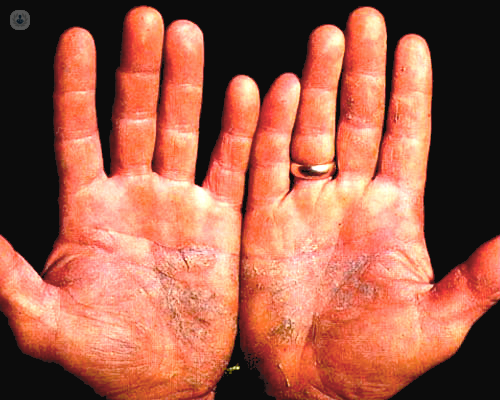Dealing with psoriasis: symptoms, causes, and treatment
Written by:Psoriasis is a lifelong inflammatory skin condition which affects around 2% of the UK population. It causes the skin to become crusty, red, or flaky usually around the elbows, scalp, knees, and lower back. These areas of skin can become itchy and painful. Although it may develop in any age group, it usually begins in adults under the age of 35. Psoriasis symptoms may appear and diappear sporadically.

What are the symptoms of psoriasis?
There are various different types of psoriasis, each exhibiting different kinds of symptoms that also vary from person to person. Some people may only have mild psoriasis symptoms such as mild irritation of the skin, whilst others may have more extreme symptoms that can cause great discomfort and affect daily life. General psoriasis symptoms to watch out for include:
- Itchy skin
- General soreness
- Burning sensation
- Patches of red skin covered in silvery scales
- Small scaly patches of skin
- Dry and cracked skin that can bleed
- Stiff and swollen joints
- Thickened nails
Although psoriasis is a chronic disease, there are normally periods when people experience no symptoms, making it seem that the condition has disappeared.
What causes psoriasis?
The definite cause of psoriasis is not completely known, however it is believed that genetics plays a role. Around 1 in 3 people with psoriasis say they have a relative who also has the condition. Aside from this, there are a number of other factors that may trigger psoriasis. These include environmental triggers such as:
- Infection
- Stress
- Skin injuries such as cuts, grazes, and severe sunburn
- Certain drugs such as lithium, quinidine and indomethacin
- Smoking
- Drinking a lot of alcohol
- Hormonal changes
An overactive immune system is also a cause of psoriasis. An overactive immune system causes inflammation due to an excessive production of healthy skin cells which are then forced to the surface. In people without psoriasis, this process usually takes around a month to complete, but it only takes a few days in people who have psoriasis. As the body is unable to get rid of skin cells so fast, the cells begin to build up and create the thick and red patches visible on the surface and synonymous with psoriasis.
Despite the unappealing appearance of psoriasis, it is important to remember that psoiraisis symptoms are not contagious and cannot be passed on to other people.
How is psoriasis treated?
Unfortunately there is still no known cure for psoriasis, however there are a number of treatments available that can help alleviate symptoms, improve appearance, and make life more tolerable.
The initial phase of psoriasis treatment usually involves a topical treatment (creams and ointments) using vitamin D analogues or topical corticosteroids. These may not always be effective, in which case phototherapy (exposing the affected area of skin to ultraviolet light) is used to treat psoriasis. This is also used in cases of severe psoriasis.
If none of the above treatments for psoriasis work, your GP or specialist may recommend systemic treatments, wherein oral or injected medicines are administered to the patient, working through the body.


